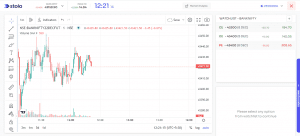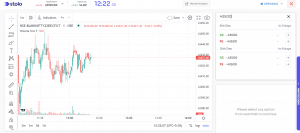While we are all excited to turn INR 100 into INR 1000 through trading, we are worried, euphoric, and bewildered. Hence, it is extremely significant that we have the right theoretical knowledge before we put our capital at stake.
So if you are looking for a guide to show you how one trades options, then you’ve landed on the right page. Here’s a step-by-step guide on how to trade options.
What is Options Trading?
Options Trading allows you to sell or buy contracts with derivatives, like stocks, by setting an expiry date and a strike price (target price) for the options with no obligation to execute them.
In simple terms, all the options you purchase will have a set deadline by which the options can be executed. If the options align with the target price you set, then you will exercise those options; however, if they go against your direction, then you can choose not to exercise your options too.
Basics of Options Trading
There are a few key elements that one needs to be aware of before stepping into options trading.
- Derivative
Derivatives can be defined as financial contracts that have or derive their value from an underlying asset.
- Strike Price
A predetermined price fixed by the trader for the options in a predetermined time is referred to as a strike price. In other words, the target price at which we agree to buy or sell an option is called the strike price.
Eg, If Reliance is currently trading at INR 2500, and I predict through my analysis that it will reach INR 3000 in the next 2 months, then my strike price will be INR 3000.
- Premium Price
An option premium is the current market price of an option contract. It is thus the income received by the seller (writer) of an option contract to another party.
E.g., If Reliance is trading at INR 2500, then you can purchase its options for a lower price, called the premium price.
- Lot Size
Options are always bought in certain numbers only. This number is determined by SEBI, and it keeps changing from time to time.
E.g., The current lot size to purchase reliance is 250 shares. So you cannot purchase 10 options of Reliance, but you need to purchase it in its lot size, which is 250.
If you need a thorough brush about options before looking at how to trade one, then you can check out: What is Options Trading? A Beginner’s Guide to Trade Options.
Step-by-Step Guide for Options Trading
- Creating a Trading Account
- Choose the Options Buy and Sell
- Predict a Strike Price for the Chosen Option
- Predict a Time Frame for the Chosen Option
- Decide Whether The Options Should Be Exercised Or Not
Step 1: Create a Trading Account
You will only need to have an options trading account/demat account linked to your bank account to allow cash settlement.
Conduct thorough research before you choose. One can use various parameters to study and select an ideal options trading platform.
You can use this detailed guide that shows you how to choose a trading platform. The guide has also listed some of the tops platforms one can choose from to make it easier for you: 10 Best Options Trading Platforms in India – Free and Paid
Documents Required for Creating an Account
There are certain documents one needs to keep handy while creating an options trading account/demat account, These documents are:
- Aadhaar Card
- PAN Card
- Cancelled Cheque
- Income Proof- Paycheck Slip or similar financial documents
Step 2: Choose the Options to Buy or Sell
This is where a lot of traders commit their first mistake. One must carefully analyse the options they might trade before stepping into it. Conduct thorough research, fundamental or technical, to choose your options.
On the basis of your research, if you believe:
- The stock price will increase from its current price on the predetermined date: Then you will opt to buy a Call Option or sell a Put Option
- The stock price will decrease from its current price on the predetermined date- Then, you will sell a Call Option or buy a Put Option.
Step 3: Predict a Strike Price for the Chosen Option
The strike price is the price we predict a stock to reach within a given time period. For example, If I say Reliance is now trending at INR 2500, but I predict that it will reach INR 3000 in the next two months, then INR 3000 will be referred to as my strike price or my target price.
These strike prices are not blindly set. These strike prices are predicted on the basis of an in-depth analysis that needs to be conducted before you make your bets on a stock. One can use various options trading strategies to determine the strike price.
This is, again, where one needs to be careful. Not one-size-fits-all. Meaning a strategy that worked once might not always work, and here too, a trial and error need to be conducted to see which options trading strategy works best for you.
Predict the Strike Price
A stock is only valuable when it moves in our direction. i.e., if it reaches the strike price we set in the given time.
In the above-given example, I’ll only earn a profit if Reliance reaches INR 3000 or more.

Step 4: Predict a Time-Frame for the Chosen Options
We all know that there is a given expiration date on which we will either execute our options or choose not to. The real question, however, is how do we choose an expiration date?
Well, just like the strike price, you cannot choose any date you want. Your options trading platform will already give you a set of options for dates to choose from.

These expiration dates could be weekly or monthly. You have the flexibility to choose any date from the given options.
There are, again, varied options trading strategies to select an expiration date which are all rooted in research and analysis of the stock’s data. Hence, even when you choose your platform for trading, make sure you have access to all the data needed to make the right assessments of the stocks.
Step 5: Decide Whether The Options Should Be Exercised Or Not
One of the key fundamentals of options trading is that there is no obligation to exercise your options. If the market moves in your favour, you can exercise the options. If it doesn’t move in your favour, then you can choose not to exercise them. Let us understand it with an example.
The above example set our strike price for Reliance as INR 3000. If the stock reaches 3000 or more, then I will exercise my options as the market has moved in my direction. Hence, I will be in profit.
However, on the other hand, if by the end of two months, Reliance reaches INR 1800, then I will be at a loss. Why?- The market price at the predetermined date or expiration date is far away from my strike price; in fact, it goes in the opposite direction.
Therefore, I will choose not to exercise them because I am not obliged to. What happens in this scenario? In such cases, I will only lose the premium price I paid to buy the options. In this case, it is (Premium Price of Reliance * 250 (lot size).
The loss here becomes limited. In conclusion, you will only lose the premium paid to buy and nothing more.
There are several options trading strategies that one may apply to make the best of every trade. However, these strategies get strengthened through research and practice.

